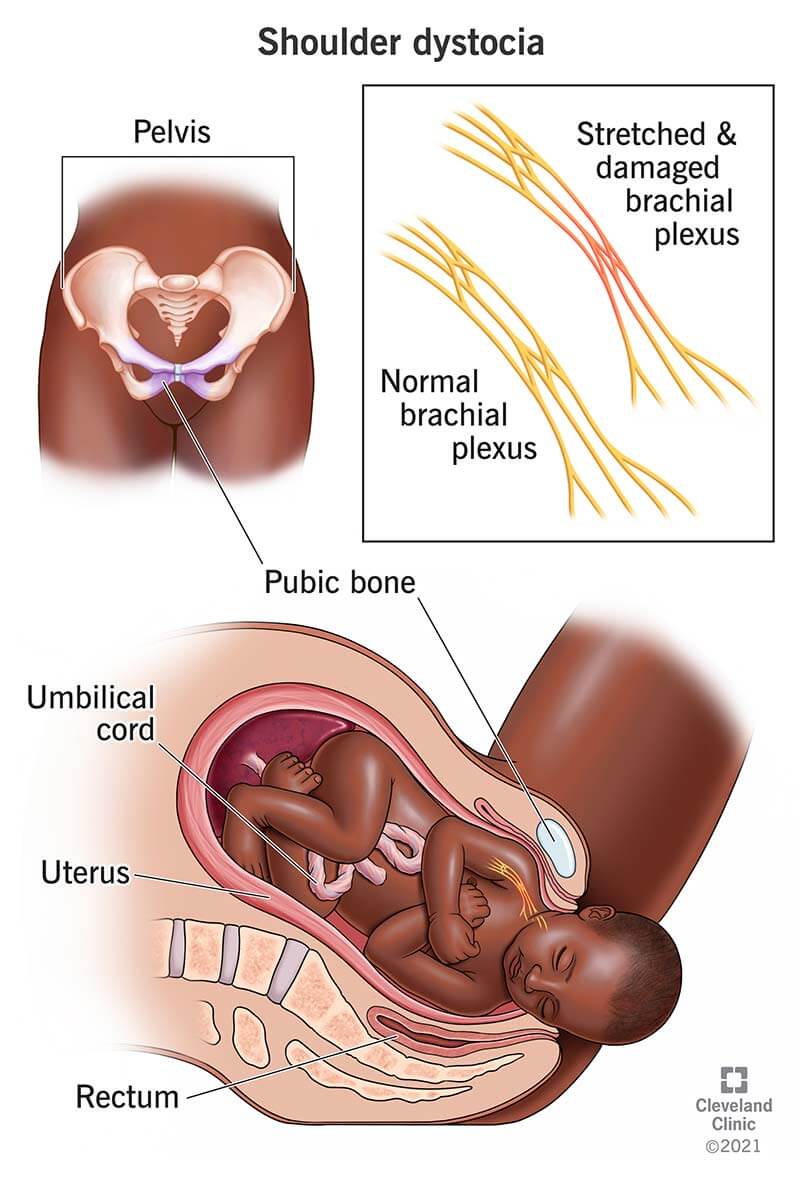Shoulder dystocia is a condition that happens when one or both of your baby’s shoulders get stuck during vaginal delivery. There are no signs and no way to prevent the condition. Causes may include having a large baby, having a small pelvis or being in the wrong position. Severe complications can occur, including nerve injuries to your baby.
Advertisement
Cleveland Clinic is a non-profit academic medical center. Advertising on our site helps support our mission. We do not endorse non-Cleveland Clinic products or services. Policy

Shoulder dystocia occurs when one or both of your baby’s shoulders get stuck inside your pelvis during childbirth. The word dystocia comes from the Greek words “dys,” meaning difficult, and “tokos,” meaning birth.
Advertisement
Cleveland Clinic is a non-profit academic medical center. Advertising on our site helps support our mission. We do not endorse non-Cleveland Clinic products or services. Policy
Shoulder dystocia is a medical emergency. Babies with this condition are usually born safely. But it can cause serious complications for you and your baby.
Shoulder dystocia is a rare condition. Statistics vary widely because the condition is sometimes over-diagnosed or underdiagnosed. The average rate also varies depending on the baby’s birth weight. Shoulder dystocia occurs in 0.6% to 1.4% of babies weighing between 5 pounds, 8 ounces and 8 pounds, 13 ounces at birth. The rate increases to 5% to 9% of babies born weighing more than 8 pounds, 13 ounces.
While there are risk factors that can lead to shoulder dystocia, the condition can happen to anyone. There are no symptoms, and there’s no way to predict if shoulder dystocia will occur. Your obstetrician may only notice the condition after you deliver your baby’s head. It becomes clear when your baby’s head emerges and then pulls back in against the area between your vagina and rectum (perineum). This is called the “turtle sign.”
Shoulder dystocia occurs when your baby’s shoulder or shoulders get stuck behind your pubic bones during delivery. The following factors may cause shoulder dystocia:
Advertisement
Your obstetrician will diagnose shoulder dystocia if three factors are met:
Your obstetrician may recommend scheduling a C-section if you have diabetes or if your baby is very big.
If you're at risk for shoulder dystocia and having a vaginal delivery, your healthcare provider will have a safety checklist ready. A safety checklist includes steps that should be taken in the event of shoulder dystocia.
Things will happen fast in the delivery room if your obstetrician diagnoses shoulder dystocia. Your obstetrician and nursing team may try several interventions or maneuvers. They may want to move you into a better position to widen your pelvis. Or they may want to move your baby into a better fetal position to move their shoulders.
The HELPERR mnemonic is a tool your healthcare team may use to treat shoulder dystocia. HELPERR stands for:
In severe cases when other techniques aren’t working, your obstetrician may use one of the following methods:
Complications resulting from shoulder dystocia during labor can affect you and your baby.
The most common complication of shoulder dystocia in your baby is brachial plexus palsy. The brachial plexus nerves run from your baby’s spinal cord in their neck through their arm. These nerves are responsible for providing feeling and movement in your baby’s shoulder, arm and hand. Damage to these nerves can cause weakness and paralysis on the affected side. Other complications to your baby may include:
Advertisement
Research has shown that by the age of three months, half of all babies born with shoulder dystocia are functioning completely. By the age of 18 months, 82% of babies are functioning completely.
If your child suffered a brachial plexus injury, the outcome is generally positive. But some interventions may affect your child’s long-term outcome. They may have trouble with fine motor skills and other uses of their affected limb. More than 90% of these injuries improve within six to 12 months. Less than 10% result in permanent injury.
If you’ve had a baby with shoulder dystocia, your chances of the condition occurring again increase by 15%. Be sure to discuss this with your healthcare provider if you plan on having more children. If you had a C-section due to shoulder dystocia, vaginal birth after cesarean (VBAC) isn’t recommended.
Advertisement
Shoulder dystocia can happen to anyone. Most cases of the condition occur in babies with normal birth weights. But certain risk factors increase the likelihood of the condition. These risk factors include:
Certain conditions during labor and delivery may also be risk factors for shoulder dystocia. The most common of these risk factors is having an assisted vaginal delivery. This means your obstetrician has to use a vacuum extractor or forceps to help deliver your baby through the birth canal. Other risk factors during labor and delivery may include:
Advertisement
Shoulder dystocia can happen to anyone. Most cases happen in babies with normal birth weights and can’t be prevented. But to lower your risk you can:
Shoulder dystocia is an injury that can happen during childbirth. It can be overwhelming to think about the things that can go wrong during labor and delivery. But it’s important to remember these conditions are rare and your healthcare team is trained on what to do. In the rare event of any complications, try to stay calm and place your trust in your providers. They’ll do everything they can to deliver your baby safely without any long-term complications.
Last reviewed on 01/23/2022.
Learn more about the Health Library and our editorial process.